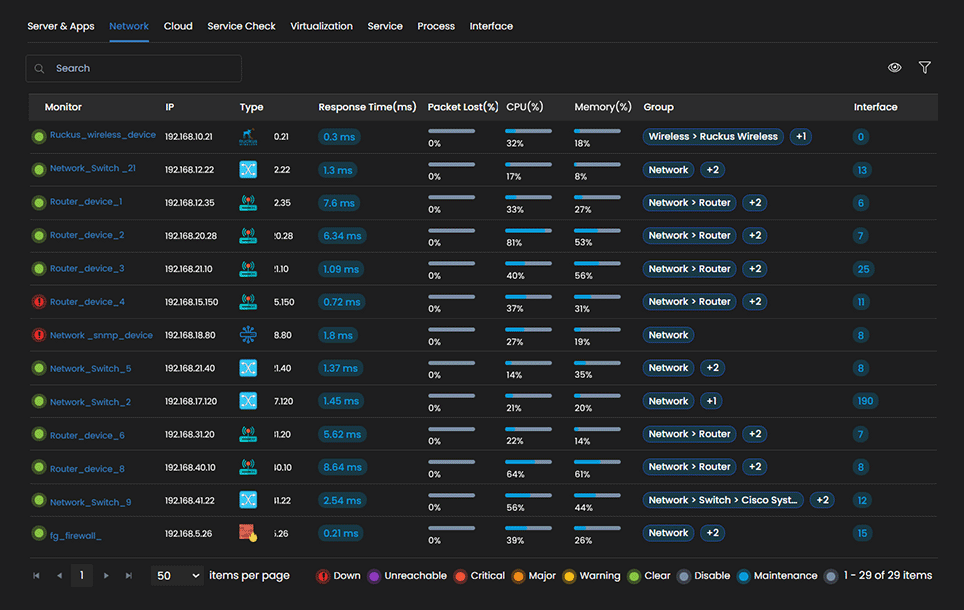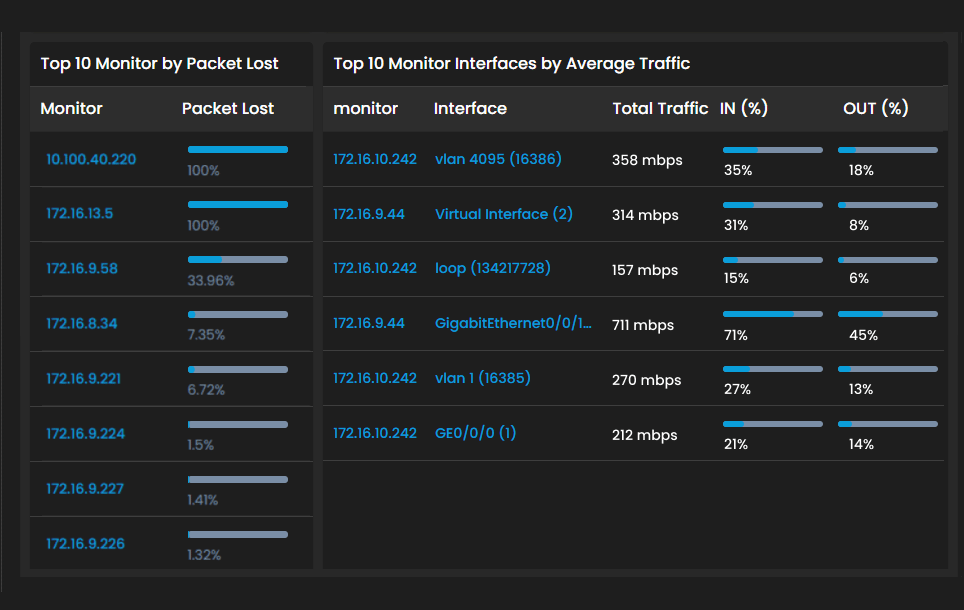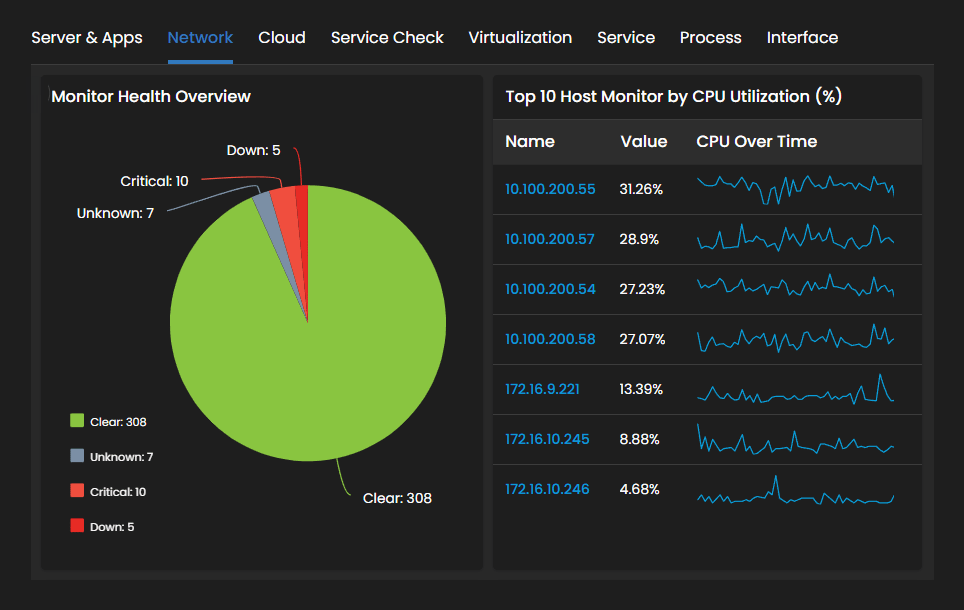The network runs critical business applications. Therefore, it is important to maintain healthy network performance and prevent network devices from inevitable damage. Network performance monitoring is a process of visualizing, tracking, optimizing, resolving, and reporting the health and performance of network devices.
Outages of network devices such as switches, firewalls, and routers can impact the network services and customer experience. Motadata AIOps predicts the potential outages of network devices such as switches, servers, and routers and proactively alerts the system to prevent the issues.
Motadata AIOps monitors the performance of IP-based devices to help enterprise visualize their infrastructure performance remotely. It also helps monitor various network services, bandwidth usage, routers, switches, and traffic flow. Once the network issues are discovered, AIOps helps improve the network performance and serve seamless network services.
Motadata AIOps also collects the log data from various network devices, analyses them, and provides actionable, rich information. Collected log data helps troubleshoot the performance issues. You can also filter out logs based on keywords, severity, and timestamp and save valuable time.
Factors Impacting Overall Network Performance
Network performance can be disturbed due to many factors. Response time – how quickly the system goes through queries and responses directly impacts the network performance. The following factors can influence network performance and help troubleshoot performance degradation.
- Bandwidth: An amount of data transmitted via cables or radio waves within a specific time. The higher the bandwidth, the more data and visa verse can be handled simultaneously. Identify the bandwidth issues, and optimize your bandwidth before it affects network performances.AIOps offers complete visibility across network traffic and lets you filter the traffic based on time intervals. In addition, it identifies network patterns and provides utilization with support for NetFlow, jFLow, sFlow, and more.
- Availability: Each second of downtime can cost thousands of money, and thus, maintaining continuous availability all the time is an absolute compulsion. AIOps reaches out to each network device at specific time intervals, ensuring all the devices are reachable for network operations.When a device does not respond with the packet or the device is down for some reason, AIOps notifies the team by sending a mail or a text message with immediate actions.
- CPU & Memory: A high CPU or memory usage on a physical server, virtual machine, or any network device can cause damage to the performance of network devices.
AIOps monitors network devices with SNMP, SSH, and native APIs. AIOps enables you to detect and troubleshoot CPU outages and resolve server bottlenecks before they cause any impact on the end-users.
- Errors & Alerts: Packet loss can disturb the performance of network devices. Such problems are common with switches and routers. As the discards increase the application latency, it indicates a problem with a switch or the device interacting with the switch.Network errors can be due to DNS issues, timeout, or even a lack of response from the server. AIOps alerts you whenever there’s a packet loss, network error, or discards.
Network Performance Analytics
Motadata AIOps collects the network data from SNMP, Flow data, packets agent, and various network devices to ensure network availability and efficient performance. Then, AIOps analyses the data and helps the admin team optimize network performance. Here are the metrics the admin team should monitor to maximize the network performance.
- Packets: Capturing the packet of data, transmitting from physical layers, helps monitor network performance and health. It also troubleshoots network services and monitors security and incident responses.
- Flow Data: Data collected from the network devices such as routers and firewalls provides information about the ongoing transmission. Information about when they are communicating, how often, how long, and how much data is transferred.
- SNMP: A network protocol that is native to IP networks and compatible with network devices. Monitoring SNMP helps network admins ensure network operations run smoothly. AIOps can provide complete visibility across network devices with the help of SNMP.
Benefits of Network Performance Monitoring with Motadata AIOps
There are many benefits of network performance monitoring. As it helps monitor the problems round-the-clock, it helps maintain a healthy network performance with high availability.
Here are the top advantages of network performance monitoring an enterprise can benefit from.
- Understand your network performance to predict, prevent and resolve network issues
- Optimize network bandwidth for better network performances
- Complete visibility across network devices to ensure smooth operations
- Grow your business and stand firm among market competitors
Network Observability with Motadata AIOps
A healthy network drives healthy network operations and leaves customers satisfied. Motadata AIOps is an advanced network performance monitoring tool that helps enterprises achieve that fit by monitoring the critical metrics of network devices. The AI-enabled solution also predicts potential issues and prevents hazardous damage.
Break data silos and achieve end-to-end network performance visibility, SNMP data, Network Flow, and log data. Effectively monitor and analyze network across on-premise to cloud infrastructure.
- Network Performance Reports: Customized reports for the set metrics, such as downtime, bandwidth utilization, CPU and memory usage, and security breaches. Generate rich reports to gain complete visibility across the IT infrastructure and make confident decisions.
- Network Performance Dashboards: Detailed dashboards with customized widgets to keep network devices transparent about their whereabouts, health, and performance. Set alerts based on a specific threshold to notify network admins before the error cause any damage
- Proactive Network Performance: Rather than reacting to the issue, monitor proactively network performance to prevent the infrastructure from facing inevitable losses, saving employees time, effort and money.



